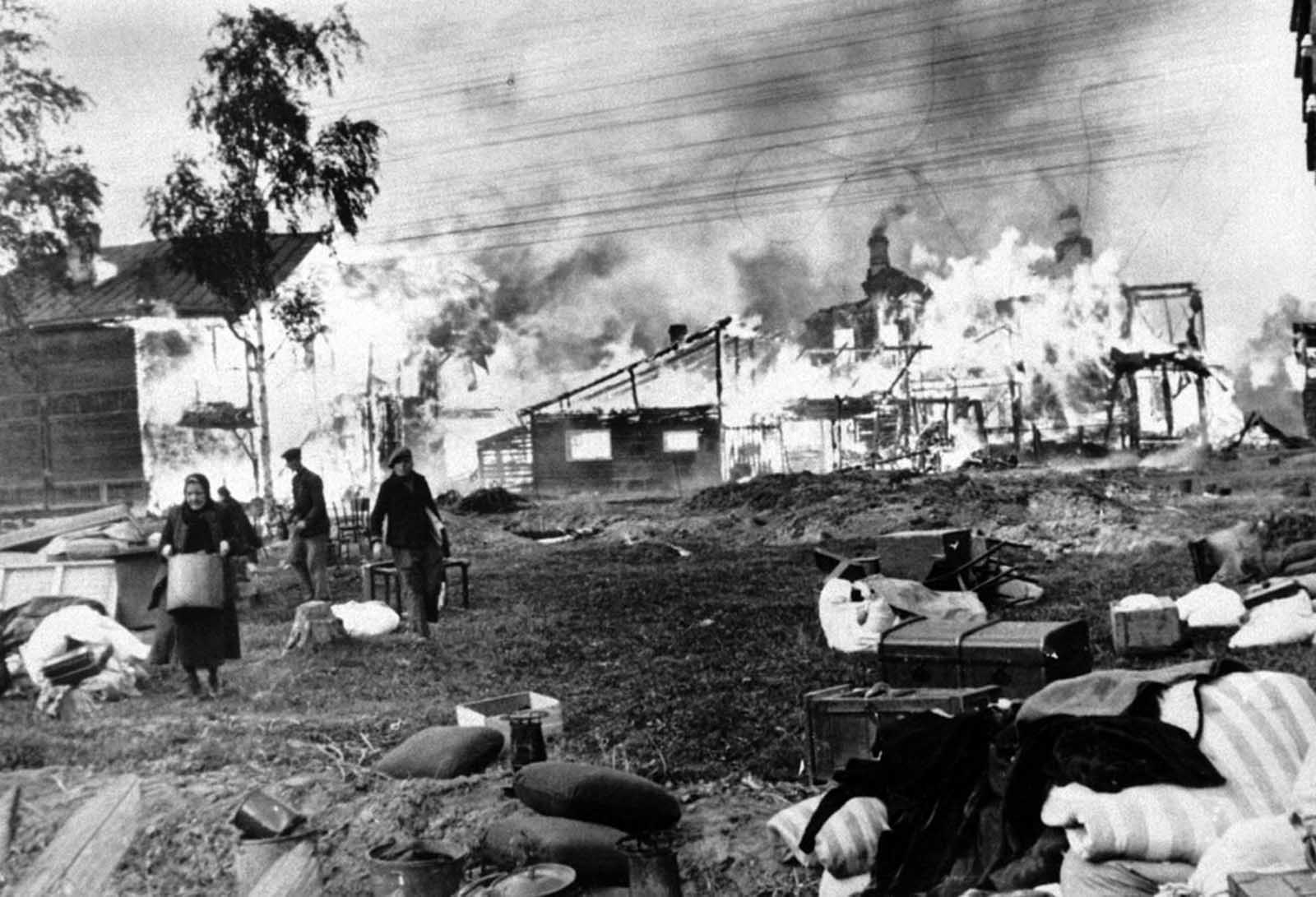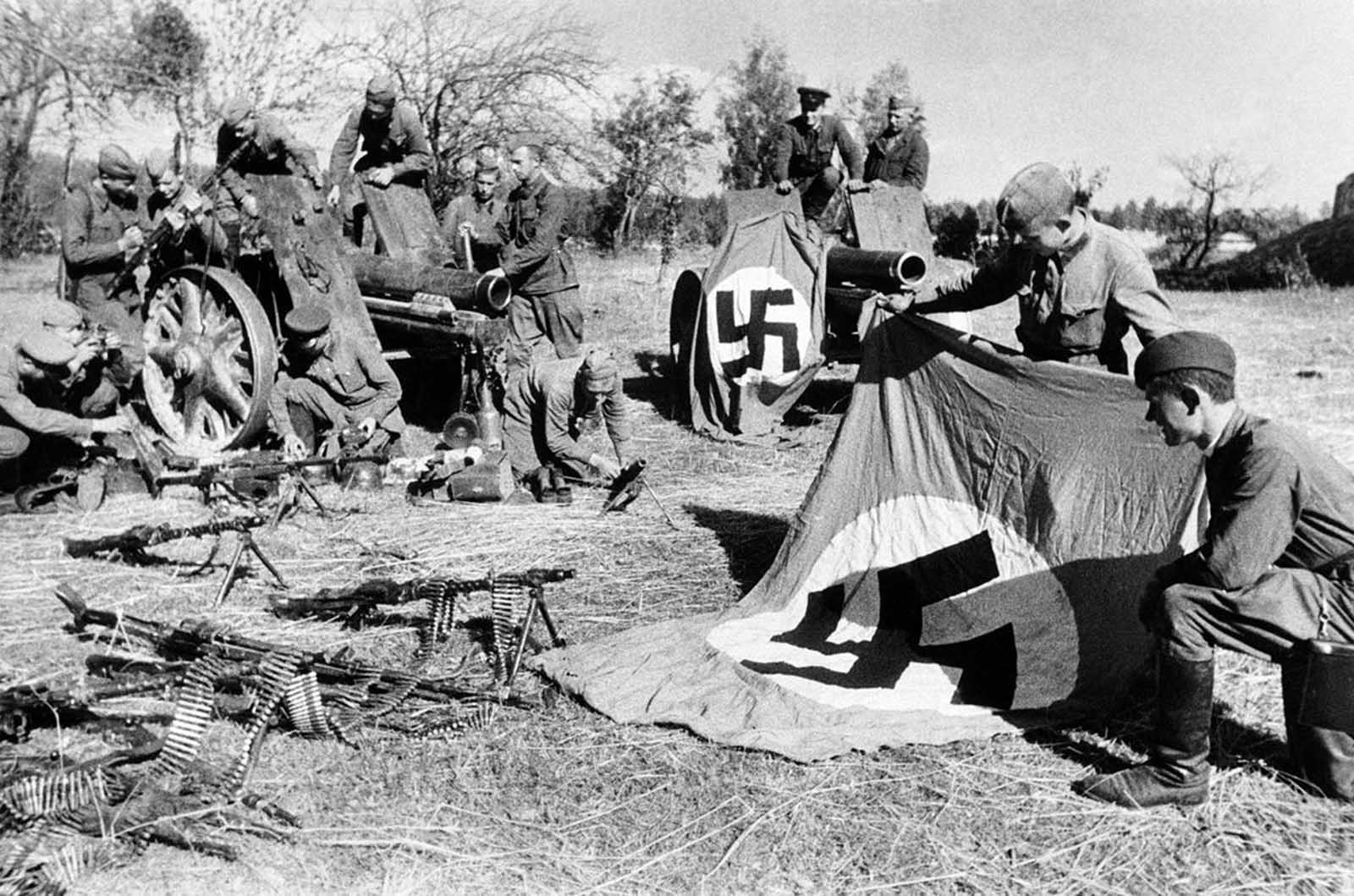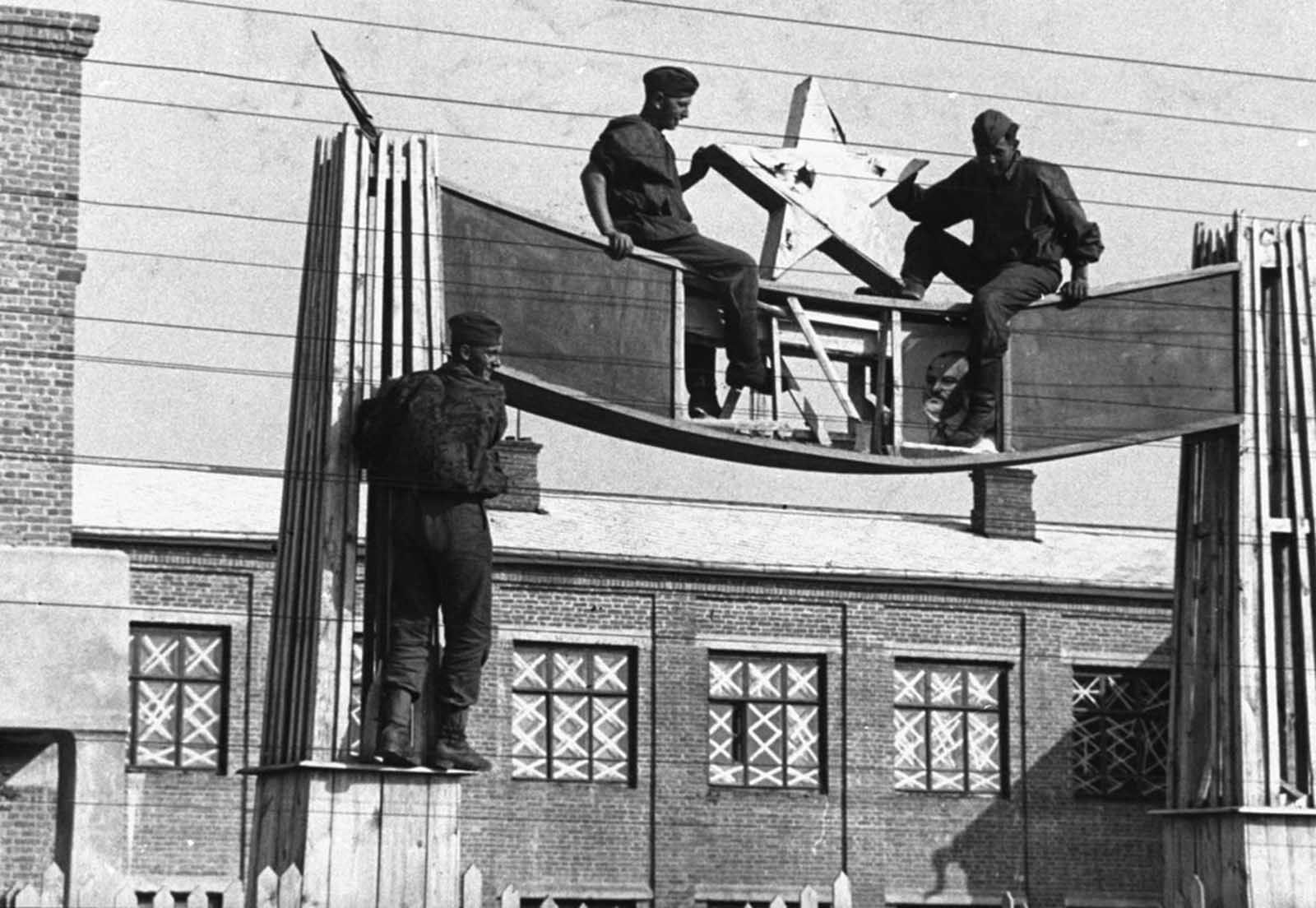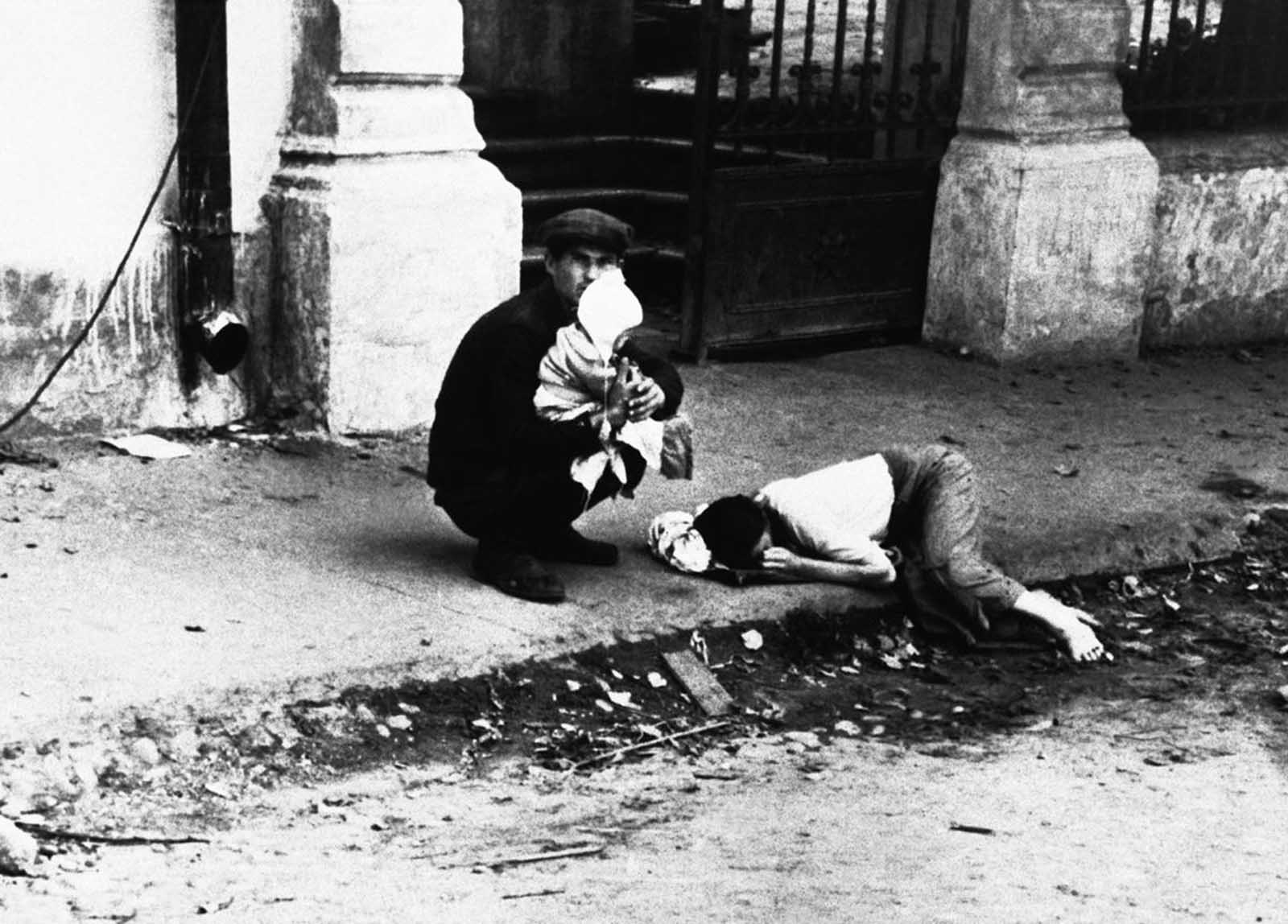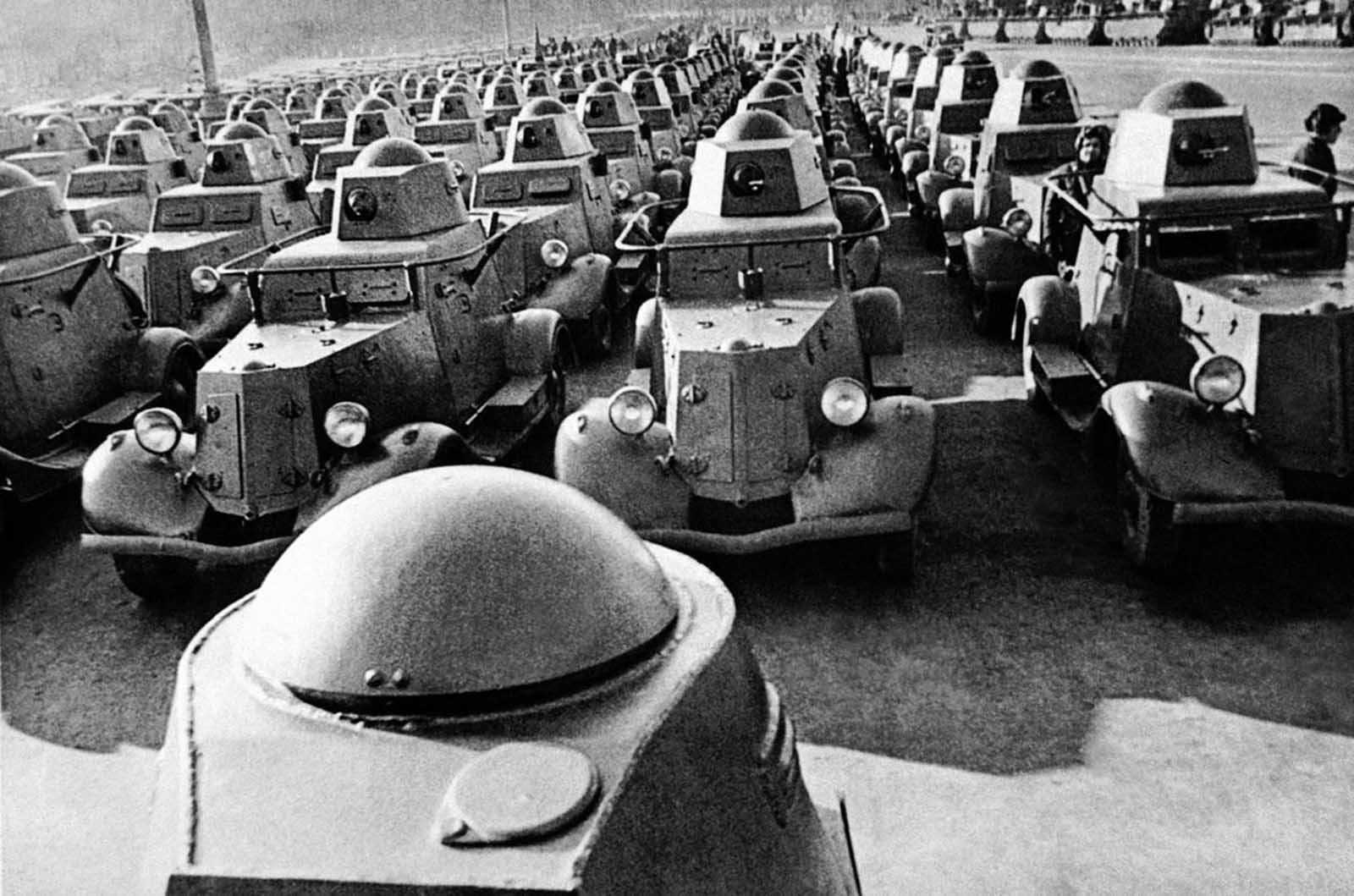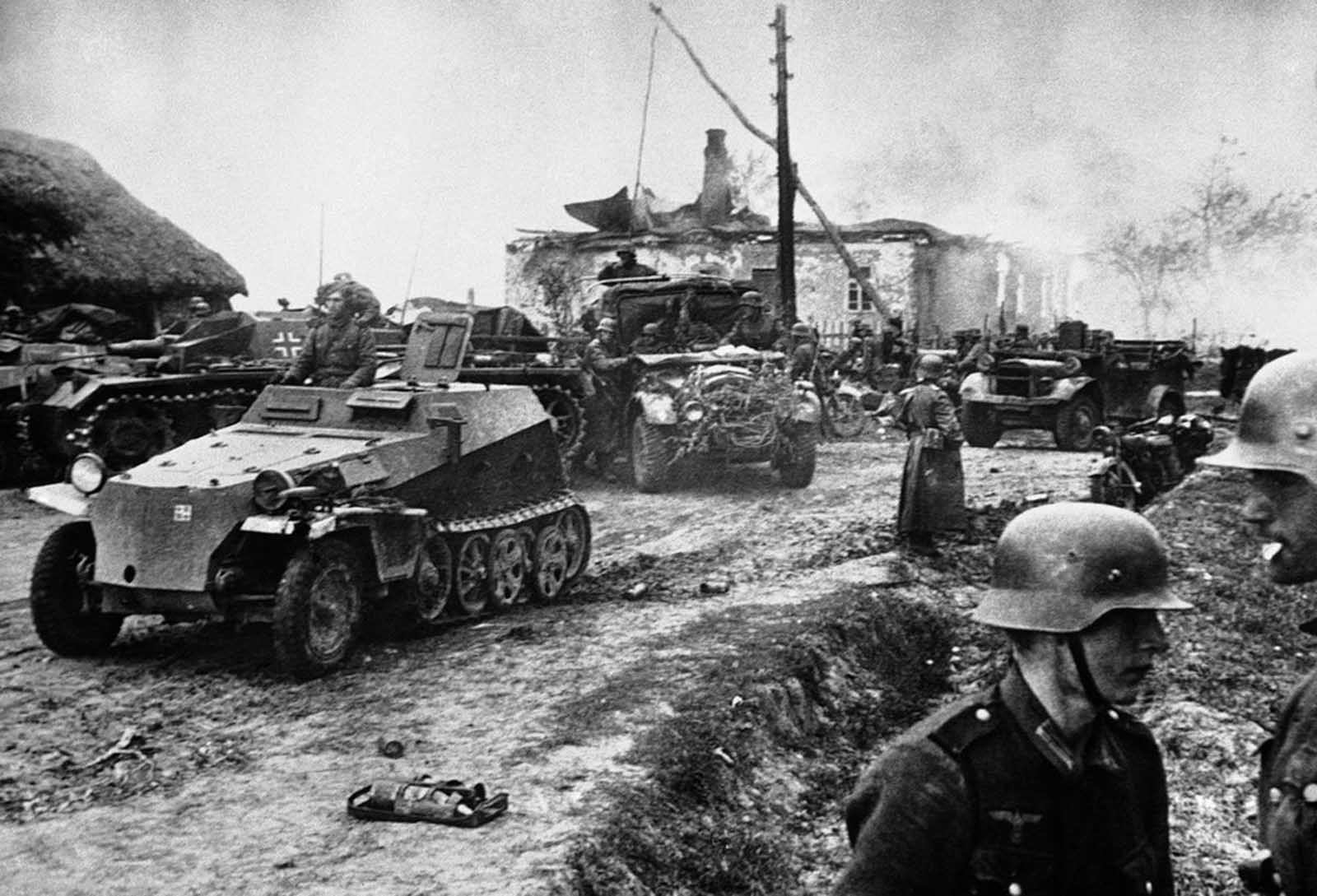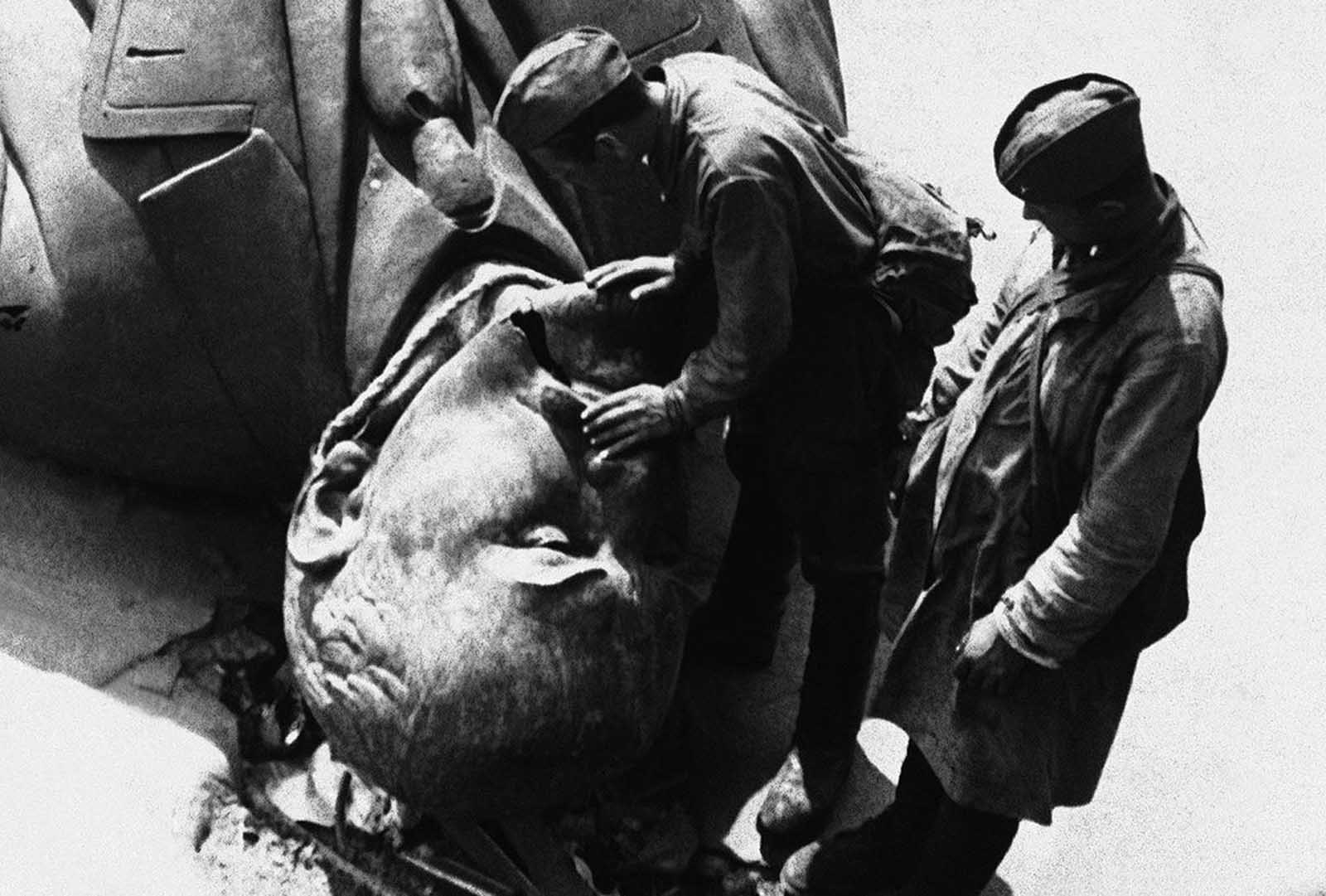It was to be the turning point for the fortunes of Adolf Hitler’s Third Reich, in that the failure of Operation Barbarossa arguably resulted in the eventual overall defeat of Nazi Germany. The Eastern Front, which was opened by Operation Barbarossa, would become the biggest theater of war in World War II, with some of the largest and most brutal battles, terrible loss of life, and miserable conditions for Russians and Germans alike. In August 1939, as Europe slid towards another world war, Germany and the Soviet Union signed a non-aggression treaty. The Nazi-Soviet Pact came as a complete surprise to other nations, given the ideological differences between the two countries. It ushered in a period of military co-operation that allowed Hitler to ignore western diplomatic moves and invade Poland. Stalin’s forces then attacked from the east and completed the subjugation and partition of the Polish state. For the next year and a half Germany also benefitted economically from the arrangement, with Russia exporting grain and oil in return for manufactured goods. Soviet cooperation allowed Hitler to expand his plans for European domination. In May 1940 the Blitzkrieg rolled westwards and France was conquered in six weeks. But peace with Russia would not last. Hitler had always wanted to see Germany expand eastwards to gain Lebensraum or ‘living space’ for its people. After the fall of France Hitler ordered plans to be drawn up for an invasion of the Soviet Union. He intended to destroy what he saw as Stalin’s ‘Jewish Bolshevist’ regime and establish Nazi hegemony. The conquest and enslavement of the Soviet Union’s racially ‘inferior’ Slavic populations would be part of a grand plan of ‘Germanisation’ and economic exploitation lasting well beyond the expected military victory. Regardless of recent economic and political co-operation, the Soviet Union was regarded as the natural enemy of Nazi Germany and a key strategic objective. On 18 December 1940 Hitler issued Führer Directive 21, an order for the invasion of the Soviet Union. The German military plan called for an advance up to a hypothetical line running from the port of Archangel in northern Russia to the port of Astrakhan on the Caspian Sea – the so-called ‘A-A line’. This would bring the bulk of the Soviet population and its economic potential under German control. After a five-week delay while operations in Greece and Yugoslavia were completed, Operation ‘Barbarossa’ – named after the all-conquering Medieval Holy Roman Emperor Frederick I – was launched on 22 June 1941. Over three and a half million German and other Axis troops attacked along a 1,800-mile front. A total of 148 divisions – 80 percent of the German Army – were committed to the enterprise. Seventeen panzer divisions, formed into four Panzer Groups, formed the vanguard with 3,400 tanks. They were supported by 2,700 aircraft of the Luftwaffe. It was the largest invasion force to date. The German forces were split into three army groups, each with a specific objective. Army Group North was to head through the Baltic States of Latvia, Lithuania, and Estonia and take Leningrad. Army Group South would attack into Ukraine towards Kiev and the Donbas (Donets Basin) industrial region. Between them, Army Group Centre’s objective was Minsk, Smolensk, and then Moscow itself. Hitler expected these all to be attained in approximately ten weeks. The Soviets had massed large forces on their western frontier, but they were under orders not to provoke the Germans. Although mistrustful of Hitler, Stalin did not believe that he would attack so soon, despite the ominous German build-up and a stream of intelligence warnings. He had some 5 million men available immediately and a total of 23,000 tanks, but the Red Army was still unprepared when the Germans struck. The Germans got off to a good start, with the panzer groups quickly pushing towards their objectives and Russian forces falling apart in confusion. They were greatly helped by the Luftwaffe’s bombing of Soviet airfields, artillery positions, and troop concentrations. The Germans quickly established air superiority. On the first day alone 1,800 Soviet aircraft were destroyed, most of them on the ground. Army Group North, under Field Marshal Wilhelm Ritter von Leeb, plunged towards Leningrad, with General Erich Hoepner’s Panzer Group 4 in the lead. Russian forces in this sector were thinly spread and the panzers covered 500 miles (804 km) in three weeks. By mid-July, they were only 60 miles (96 km) from their objective. Army Group Centre, under Field Marshal Fedor von Bock, also made rapid progress. By 28 June Panzer Group 2, led by General Heinz Guderian, and General Hermann Hoth’s Panzer Group 3 had encircled three Russian armies and captured over 320,000 men in the Bialystok-Minsk pockets. The two panzer groups then pressed ahead, linking up on the far side of Smolensk on 27 July in another double envelopment. Two more Russian armies were trapped and destroyed, and another 300,000 troops taken prisoner. Army Group South, under Field Marshal Gerd von Rundstedt, had the furthest to go and his attack also faced the stiffest Soviet resistance. Most of the Russian armor was on this front. But by early July von Rundstedt had pushed out beyond the pre-1939 Polish frontier.
Why Operation ‘Barbarossa’ failed?
Operation ‘Barbarossa’ had clearly failed. Despite the serious losses inflicted on the Red Army and extensive territorial gains, the mission to completely destroy Soviet fighting power and force a capitulation was not achieved. One of the most important reasons for this was poor strategic planning. The Germans had no satisfactory long-term plan for the invasion. They mistakenly assumed that the campaign would be a short one and that the Soviets would give in after suffering the shock of massive initial defeats. Hitler had assured the High Command that ‘We have only to kick in the front door and the whole rotten edifice will come tumbling down’. But Russia was not France. The shock value of the initial Blitzkrieg was dissipated by the vast distances, logistical difficulties, and Soviet troop numbers, all of which caused attritional losses of German forces that could not be sustained. General Ewald von Kleist’s Panzer Group 1 was slowed by Soviet flanking attacks as it headed for Kiev, the capital of Ukraine, and the key to the coal-rich Donets Basin. On 8 August the Germans surrounded two Soviet armies, capturing 100,000 men in the Uman pocket, and reached the Dnieper River. The naval port of Odesa on the Black Sea was also besieged. Up to this point, all seemed to be going well, the only major problem being the time needed for the infantry to catch up with the panzers and mop up pockets of Russian defense. But Soviet resistance was now stiffening, despite catastrophic losses. A German salient around Yelnya, south-east of Smolensk, was recaptured in a costly but successful counterattack.
Soviet tank superiority
While the Germans underestimated the military potential of their opponents, they also exaggerated the capabilities of their own forces, most significantly the four Panzer Groups. The panzer divisions were the principal weapon of Blitzkrieg and at that time were far superior to the Soviets in training, leadership, and tactical ability. But they were relatively weak in numbers and equipment. German tank strength had been halved in 1940 so that the number of divisions could be doubled. Over half the tanks committed to ‘Barbarossa’ were obsolescent light tanks and Czech-built models, rather than the more capable PzKpfw III and IV. And there were virtually no reserves available. Hitler had so far refused to fully mobilize the German economy and so weapons production was inadequate. Even in mid-1941, only 250 new tanks were being built each month, insufficient to properly equip the army on the eve of a major new campaign, or keep up with the inevitable mechanical and combat losses. Hitler even chose to divert some of these to France and other theatres, when the demand was greatest in Russia. The vast majority of the 10,000 or so Russian tanks facing the Germans in June 1941 were light BT series tanks or obsolete T-26 models. Huge numbers were destroyed in poorly planned and executed counterattacks. But Soviet tank development and production were already superior to that of the Germans. A new generation of tanks had entered service, namely the T-34 and KV-1. The T-34 in particular was a major leap in tank design and came as a complete shock to the Germans when it was first encountered in July 1941. In September, with the aid of their Finnish Allies, they cut Leningrad off from the rest of Russia but lacked the strength to take the city. Instead, Hitler ordered that it be starved into submission. The epic siege would last 890 days. Hitler now decided to resume the battle for Moscow. On 2 October he unleashed Operation ‘Typhoon’. He believed the Russians had been fatally weakened and lacked the strength to defend their capital – one more push would see it fall and victory would be his. But the Red Army had been reinforced. It had sloping armor – which effectively doubled its strength – and a powerful 76.2mm gun. Its reliable diesel engine gave it a good range and turn of speed, and its wide tracks could cope with mud or snow. Russian industry was already gearing up to turn it out in huge numbers. Less than a thousand T-34s were available at the start of ‘Barbarossa’ and most were squandered in piecemeal actions by half-trained crews. But the Red Army could absorb significant losses of equipment as well as men. The mass mobilization of Soviet industry had been set in train, which included relocating vital tank, aircraft, and munitions factories eastwards to the Urals. This huge logistical undertaking was already bearing fruit. It meant that despite the early defeats, the Soviet Union was far better prepared for a long war than the Germans, whose own production of tanks and other weapons would be feeble by comparison. Meanwhile, Army Group Centre’s supply situation was becoming critical. Hitler decided to halt the advance on Moscow and reinforce Army Groups North and South. Hoth’s Panzer Group 3 was sent north to support the drive on Leningrad while Guderian’s tanks were despatched to help Army Group South take Kiev. The German High Command protested vigorously. The panzers were only 220 miles from Moscow. But Hitler regarded the resource-rich Ukraine as more important. On 21 August he ordered that the conquest of the Crimea and the Donets Basin be given priority. The Soviets were completely fooled by German moves. Five Soviet armies were trapped in a vast salient around Kiev. As usual, Stalin refused to sanction a withdrawal before the pocket was sealed. By the end of September, Kiev had fallen and over 650,000 Russian troops killed or captured. The Germans pushed along the Black Sea coast and into the Crimea, laying siege to Sevastapol. In October Kharkov fell, but by now the Germans were exhausted. The fighting had severely depleted their ranks and supply lines were stretched to the limit. For now, the southern front stayed where it was. In the north too, German forces had reached their limit. Almost a million Soviet troops were in place, although they had few tanks and aircraft left. A multi-layered ring of defenses had been thrown around the capital and its citizens had been mobilized. The German offensive was carried out by a reinforced Army Group Centre, comprising three infantry armies and three panzer groups – 1 million men and 1,700 tanks. However, the Luftwaffe was weak after over three months of sustained operations. And the weather was beginning to turn. Once again the initial assault was a success. The panzer divisions stormed ahead and over 600,000 Russian soldiers were captured in two more huge encirclements near the cities of Bryansk and Vyazma. The Russians were down to about 90,000 men. But as they reached the approaches to Moscow, the German formations slowed to a crawl. Autumn rains had turned the dirt roads into rivers of mud. It was the Rasputitsa – the ‘quagmire season’ – and wheeled and horse-drawn transport became hopelessly stuck. The Germans chose to temporarily halt operations. In mid-November, with the temperature dropping and the ground now frozen hard, the panzers attempted a final pincer attack around Moscow itself. The delay had given the Soviets time to bring in further reinforcements, including reservists and troops from Siberia and the eastern borders. The northern German pincer was the most successful and got within 12 miles of the city. German officers could see the Kremlin buildings through their field glasses. The Germans also tried attacking in the center, along the Minsk-Moscow road. On 2 December a reconnaissance unit got within 5 miles of Moscow. Though tantalizingly close, this was the limit of the entire advance. The depleted German units were exhausted and frozen into inactivity in the deep snow. On 5 December the Soviets launched a surprise counter-offensive. The Germans were forced into a retreat, despite Hitler’s call to defend every foot of ground. Guderian and several other senior generals who advised withdrawal were sacked. The Russians succeeded in crushing various German formations in encirclements of their own. The Luftwaffe struggled to operate but performed vital work ferrying supplies to cut off units and harrying the Russian advance. Army Group Centre was pushed back up to 150 miles from Moscow. A furious Hitler dismissed the commander-in-chief of the German Army, Field Marshal Walther von Brauchitsch, and appointed himself in his place.
The impact of Hitler’s involvement.
Hitler’s input has been heavily criticized, not least by his generals at the time. Moscow was always a more important objective to the German High Command than it was to Hitler, who was more concerned with destroying Soviet field armies and capturing vital industrial resources. His switching of the main thrust from the central front to Leningrad in the north and Ukraine in the south was to an extent militarily sensible given the weakness of Army Group Centre after the Smolensk battles and the threats to its flanks. Indeed, the diversion actually worked in the Germans’ favor since it surprised the Soviets and resulted in the destruction of huge Soviet forces around Kiev. But it also threw away Germany’s only real chance of outright victory. The early capture of Moscow would have had an undeniable psychological impact and may have been the tipping point. Guderian in particular believed that using the panzers in traditional encirclement battles played into Russian hands and gave them chances to bring forward fresh reserves. He had advocated an all-out drive on the capital. But when Hitler resumed the assault with Operation ‘Typhoon’ it was too late. The German Army was now fatally weakened, the weather had worsened and Soviet reinforcements had arrived.
German logistical problems
Logistics was another hugely important factor in the German defeat. No matter how fast or far the fighting formations advanced, they were dependent on timely supplies of fuel and ammunition. This became an even greater problem as the army progressed deeper into Soviet territory and further away from its own railheads. Not only were the distances much greater than they had been during the French campaign, but the Soviet transport infrastructure was much poorer. German engineers struggled to convert the Russian railway gauge to one which their own locomotives and rolling stock could use. Meanwhile, the multitude of lorries and horse-drawn wagons in which the supplies were transported were forced to negotiate Russian dirt roads, which became virtually impassable after prolonged rain. The debilitating effects of the weather and terrain were not properly taken into account when planning the campaign. The numerous forests, marshes, and rivers slowed the advance during the summer. The autumn Rasputitsa and the onset of the brutal Russian winter brought it to a halt during Operation ‘Typhoon’. Tank and vehicle lubricants froze as temperatures plunged to record lows. Winter clothing supplies were held up in Poland, as fuel and ammunition took priority. If anything symbolizes the failure of ‘Barbarossa’ it is the image of inadequately equipped German troops shivering in the snows before Moscow. (Photo credit: Deutsches Bundesarchiv / AP Photo / Library of Congress / Text: Ian Carter). Notify me of new posts by email.
Δ Subscribe













